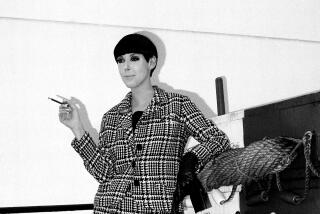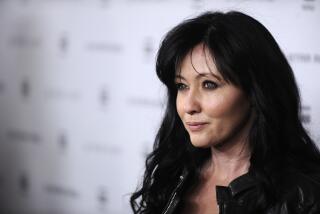Melanie Griffith, the Heroine
She walks into the Polo Lounge at teatime, a sunny-faced long stem of a woman in an elegant charcoal-gray pants suit, low-key makeup, blond curls caught up in a comb-clasp and flat shoes, and profusely apologizes for being seven minutes late. She is alone--no entourage, not even a publicist, just a trail of Cartier perfume.
Is this the same Melanie Griffith, so scathingly portrayed as the demanding, petulant movie star with bags under her eyes in Julie Salamonâs best seller âThe Devilâs Candyâ--the book about the making of the 1990 movie âThe Bonfire of the Vanities,â in which Griffith was the master-of-the-universe stockbrokerâs rich mistress?
Now Griffith has come to promote âShining Through,â which opens today--her 18th movie in about as many years of doing movies--based on Susan Isaacsâ best-selling novel. In what is clearly her most serious and demanding role to date because she is in virtually every scene, Griffith plays Linda Voss, a secretary-turned-spy in Nazi Germany during World War II. Master spy Ed Leland, an OSS colonel and love interest in the movie, is played by Michael Douglas.
The plane was late from Pebble Beach, where husband Don Johnson was practicing for a golf tournament, says Griffith in a honeyed voice. âWe got to spend a couple of days by ourselves without the kids, and it was just great. I mean , not to be without the kids, that didnât come out right. But . . . to be alone is important sometimes.â
Johnson, the former âMiami Viceâ star whoâs trying to carve out a movie career as well, is her first and third husband. They have three children--his, a son Jesse, 9, who is living with them; hers, Alexander, 6, with her second husband Steven Bauer, and theirs, daughter Dakota, who is 2.
To hear Griffith, she has done her best work on âShining Through.â And that includes âWorking Girlâ (1988) in which she was Tess McGill, the ambitious Wall Street secretary from Staten Island with âa head for business and a bod for sin,â the movie which won Griffith a Golden Globe for best actress as well as an Academy Award nomination.
Her character this time is a working girl from Queens--the daughter of a Jewish father and an Irish mother--who poses as a nanny in wartime Potsdam. Speaking German with âthe accent of a Berlin butcherâs wife,â Griffithâs character also has the guts--or chutzpah, as Voss says her father calls it--to match.
âI think sheâs like any of us,â Griffith says, speaking as though Voss were a real person rather than a fictional creation. âSo many women do so many heroic things that are never told about . . . and I thought Linda Vossâ intentions were so good. She didnât go into Germany out of wanting to die because her love affair with Ed Leland didnât work. She went there for the right reasons--to do something about the war, and to try and help her (Jewish) cousins. And I just thought she was very noble. I mean everybody goes to the movies and (itâs better) if you can give out a good message as opposed to a shoot-âem-up, kill-âem or Iâm-so-(screwed)-up kind of message which is so prevalent these days.â
Griffithâs own life has traces of heroism if you count the fact that she is, as she calls herself, a âsurvivor.â In mid-1988, she went to the Hazelden Clinic in Minnesota for treatment of alcohol and cocaine abuse, and emerged several months later a woman on the mend. She credits Johnson, whom she remarried after her recovery, with helping to see her through.
Griffith certainly has had her share of trauma: for her 6th birthday getting as a present from Alfred Hitchcock a doll of actress mother Tippi Hedren, encased in a pine box and wearing an outfit from âThe Birdsâ; moving in at 14 with Johnson, whom she had met on the set of âThe Harrad Experimentâ (which also starred her mother), marrying him at 18 and being divorced by 19; being mauled by a lion on the set of âRoarâ and getting into a serious automobile accident on Sunset Boulevard in her early 20s, and the alcohol abuse that lasted nearly a decade.
âI think Iâve had enough,â Griffith says with tinkly laughter, âbut you know something? I guess Iâve always been honest about what Iâve been going through, and I probably said too much at times. Iâm 34, I have three children, Iâm totally clean, my husband and I are madly in love, and I work . . . as much as I can.â
â âShining Throughâ had a big impact on me,â says Griffith, whose credits also include a number of TV movies. âIt was very hard. It took everything I had. I think I gave the most of myself. I felt I had to be so raw. I gave my all, and I think it was the first time that Iâve ever really done that and not been scared.
âWith Mike Nichols (on âWorking Girlâ) I gave everything because he has a way of just getting you to do anything. But I think (with) the material and the subject matter in âShining Throughâ I got to add a lot of depth that not necessarily anybody will ever see or need to know about. . . . I didnât skimp on anything. I didnât take any shortcuts or fake it, or try to get by. There are ways you can play things where you know theyâre going to look good or youâre going to come off well. But there is another way of doing it, and that is from your heart and soul.â
The movie, shot while East Berlin was undergoing reunification, turned out to be a learning experience for Griffith. The actress, who attended Our Lady of Corvallis, a Catholic girlsâ high school in Studio City, and graduated from the Hollywood Professional School, stirred controversy for her comments on the Holocaust in the New York Daily News: âI didnât know that 6 million Jews were killed. Thatâs a lot of people.â
Asked about that, Griffith told The Times that âuntil I started researching the movie I didnât know it was that many people. I thought it was like in the hundreds of thousands. I didnât realize it was 6 million people. What I was trying to say was I think a lot of people donât know it was that severe. I wasnât born during the war. I was born in â57 . . . but I think a lot of people donât know.â
If thereâs any comparison between the secretaries Voss of âShining Throughâ and McGill of âWorking Girl,â Griffith says, it is that theyâre both âunderdogs . . . I think people presuppose what people are going to do with their lives, that this is it for them, that theyâre secretaries and they donât have the ability to do anything more, donât even give them a chance to do that. Thatâs what I guess draws me to these characters. Iâve had to struggle all my life. Itâs not just women, itâs men too. I hate it when people judge you and say, âThatâs all you can do.â â
At first, Griffith had a trio of wanton Lolita roles in movies. Her first movie was the 1975 suspense thriller âNight Movesâ in which she played a teen-ager. In the same year she was seen in âSmileâ as a beauty pageant contestant who was, according to the script, âhot, sweet and dumb,â and as an oil baronessâ oversexed daughter who plays up to Paul Newman in âThe Drowning Pool.â
Griffith made a career breakthrough in 1984. Though she played porno star Holly Body in Brian De Palmaâs âBody Double,â critics began comparing her to Judy Holliday and Goldie Hawn. âBonfire of the Vanitiesâ was her second movie with De Palma.
About the only time she loses her cool is talking about that trenchant work, âThe Devilâs Candy.â âIâm not going to read the book. I donât know why anybody would want to. Maybe I was (demanding) but that was a hard shoot too. . . .â
These days, Griffith is busier than ever. Besides âBonfireâ in 1990, there was also the thriller âPacific Heights,â and last fall in âParadise,â she and Johnson were cast as parents who had lost a child and renew their relationship through a child who comes to visit.
In April, she and Johnson will begin work on a remake of âBorn Yesterdayâ in the Holliday and William Holden roles. In summer, an untitled Sidney Lumet project, formerly known as âClose to Eden,â is set to open in which Griffith plays an undercover Irish policewoman who falls in love with a rabbiâs son while investigating a murder in the Hasidic community of Brooklynâs Borough Park.
Griffith dismisses talk that her career is booming while Johnsonâs is languishing. Ironically, it was Johnson who said to her when she was 16: âWhy donât you do something?â
âIn this business people, can go for three years and not have a hit,â Griffith says, âand then itâs like those (years) never existed. And Don has been going through a major change. After doing (âMiami Viceâ) which was like the biggest series yet, and doing it for five years, he hasnât wanted to do very much. Heâs having a good time, he says, of being with his family.â
The excesses of the â80s, meanwhile, have given way to the austerities of the â90s. âWe started this whole new healthy thing where weâre not having any caffeine or any sugar or any yeast in our family,â she says. No red meat and, as of three weeks ago, no more cigarettes for Griffith. Though they also have homes in Miami Beach and Beverly Hills, the familyâs favorite spot these days is a 20-acre ranch in Aspen where they ski and hike and ride mountain bikes.
Itâs not all austerity. On her left hand, Griffith sports a four-carat diamond from Johnson when they were engaged and on her right hand, a ruby ring with diamonds from Johnson as a Christmas gift. âDuring the whole 12 years we were apart, we were always on and off,â she says. âSo this May it will be our 20th anniversary.â
More to Read
Only good movies
Get the Indie Focus newsletter, Mark Olsen's weekly guide to the world of cinema.
You may occasionally receive promotional content from the Los Angeles Times.










